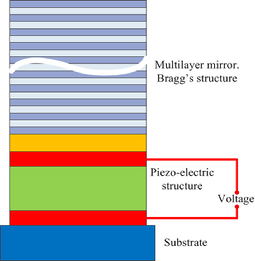SMILE2: Smart Multilayer Interactive Optics for Lithography at Extreme UV Wavelengths
Project number: HTSM i30
Title: Smart Multilayer Interactive Optics for Lithography at Extreme UV Wavelengths (SMILE2)
Executive organisational unit: XUV, MESA+ Institute for Nanotechnology, University of Twente
Programme management: Prof. Dr. F. Bijkerk (f.bijkerk@utwente.nl)
Duration: 2014-2020
Researcher: Dr. Reza Nematollahi, P. Lucke, MESA+
Daily supervisor: Dr. A.E. Yakshin, MESA+
Industrial partners: Carl Zeiss SMT GmbH, DEMCON, SolMates
Objectives
To develop multilayer wavefront correcting optics for the XUV wavelength range.
Background, relevance and implementation
Current photolithography systems are at their imaging resolution limit, helped by ingenious technologies, such as immersion lenses and double patterning. In order to further increase the resolution it is planned to reduce the operational wavelength from 193 nm to 13.5 nm: the Extreme UV or EUV.

EUV lithography represents today’s most advanced optical imaging method and can increase the optical resolution of future practicle processes.
Nowadays, mirrors with a so-called multilayer Bragg structure can reflect about 70% of the EUV light, but the remainder is absorbed causing thermal load and distortions of the reflected wavefront. A solution to this problem is to add adaptive optical functionality. A first exploration of Smart Multilayer Interactive Optics for Lithography at Extreme UV Wavelengths (SMILE) has successfully been executed. Based on this, a new multilayer composition is proposed, including piezo-electric layers that allow to interactively manipulate the periodic Bragg structure. Steering such layers with external electrical signals will allow wavefront corrections and localized optical changes with precision down to the tens-nanometer range.
The SMILE2 project aims to combine various deposition technologies of thin layers with different atomic arrangements: layers with amorphous, crystalline and polycrystalline structures in different regions of the multilayer stack. This translates to the development of hybrid systems that are new and challenging, yet based on individually demonstrated film properties.
The University of Twente collaborates with Carl Zeiss SMT, Demcon, and SolMates through this research grant from the High Tech Systems and Materials (TKI) governmental funding scheme.
